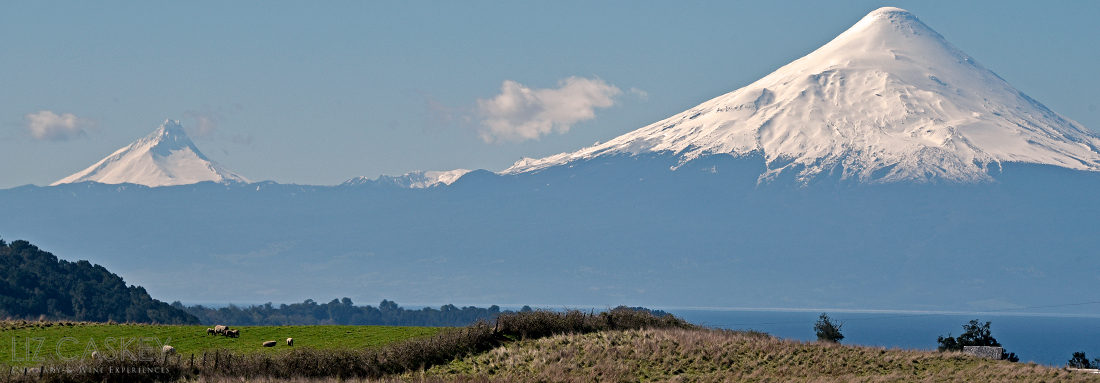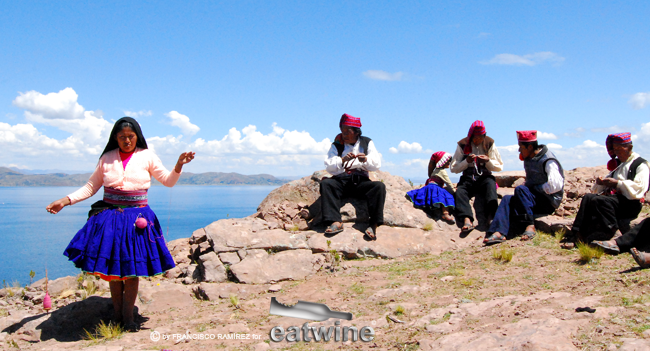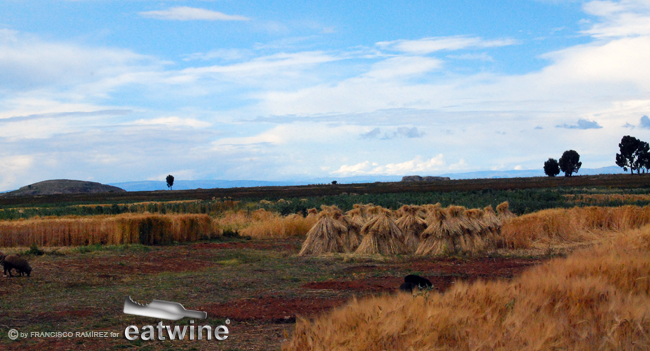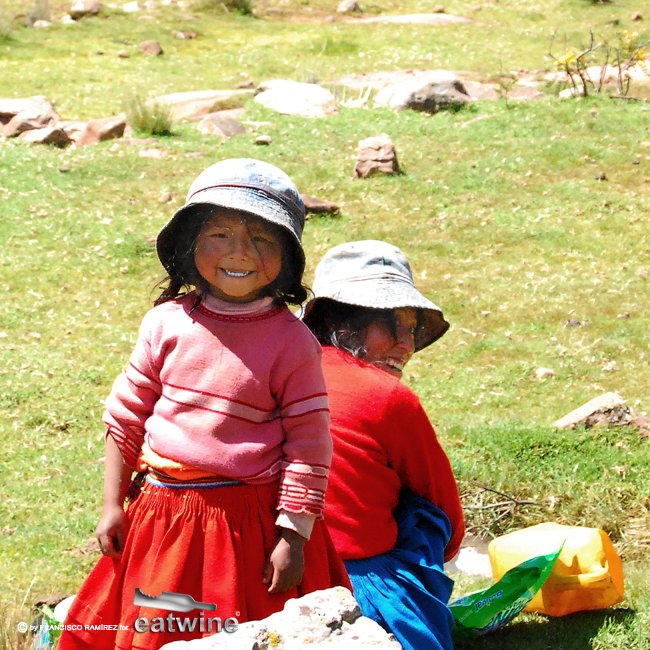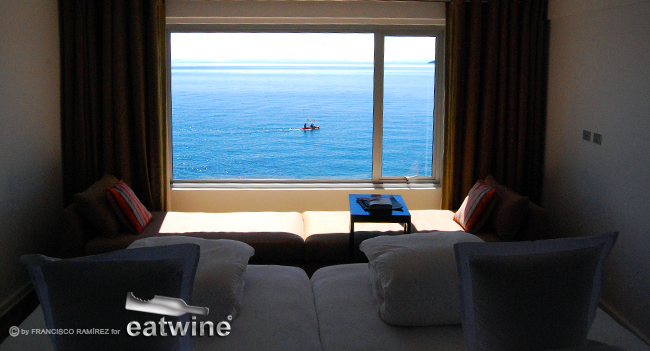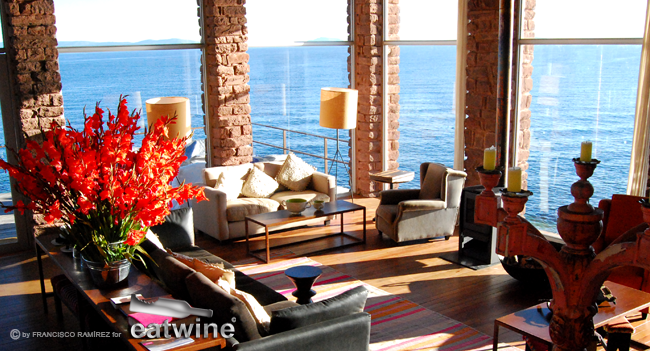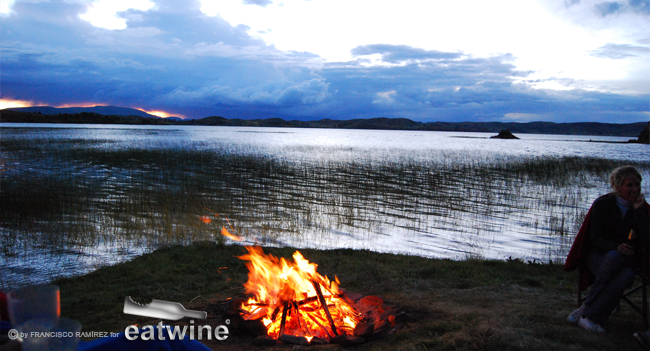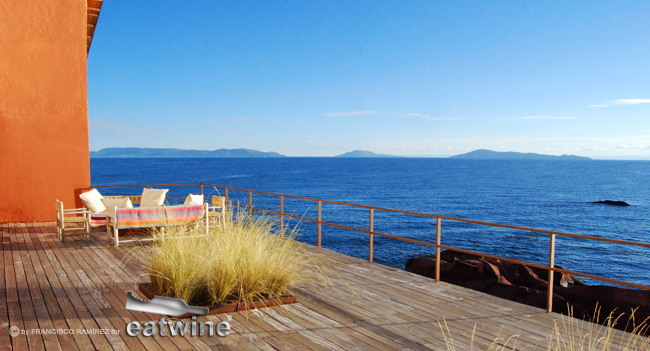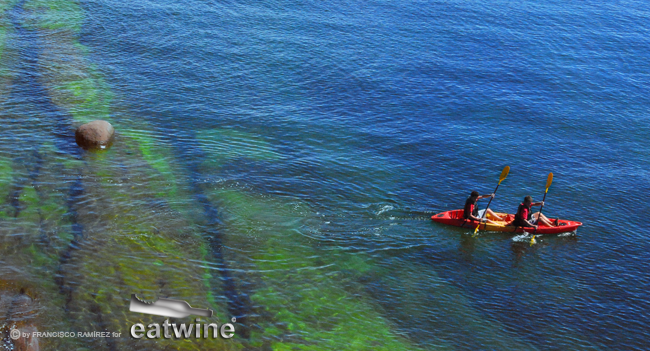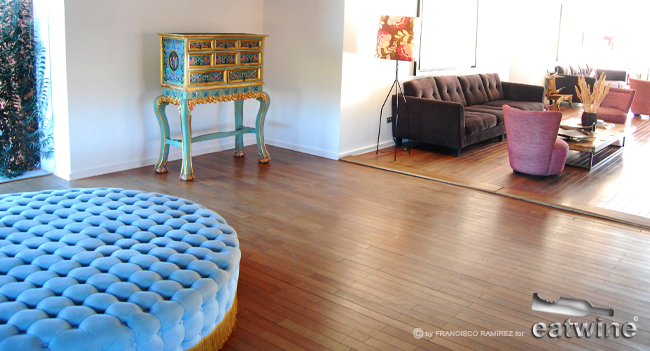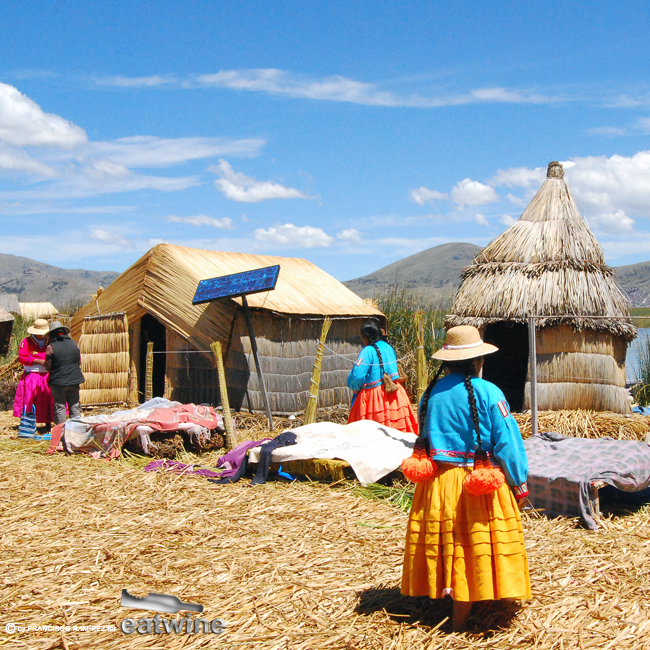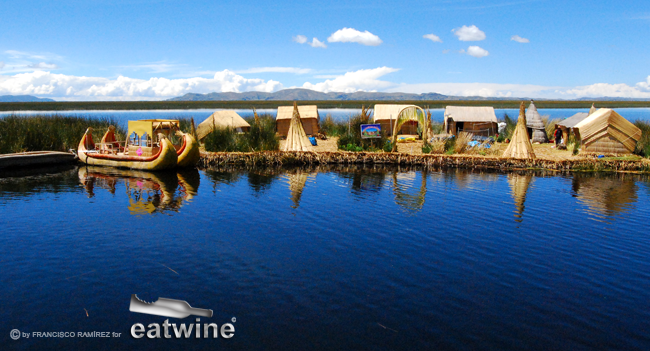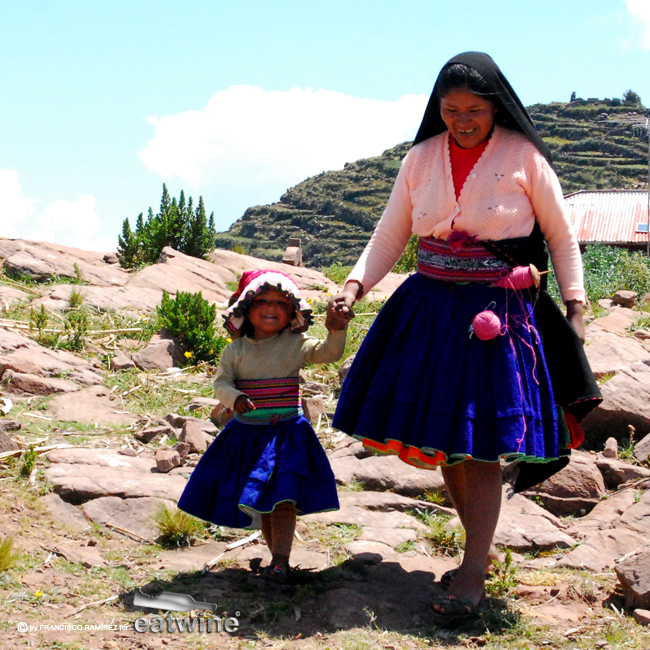(In case you missed it, check out the prequel to this post in the Peruvian Altiplano)
The sun shines off the water like a reflecting pad, its glare penetrating my eyelids.
“What time is it, anyways?”
I glance over at my iPhone and the time says 4:59am. That has to be a mistake. If it weren’t for the sun in the eastern horizon, I would swear its noon anywhere else.
Lake Titicaca transforms as the sun rises in the east and sets in the western sky over the hills. In the morning, it’s a deep sapphire blue. As the sun reaches its highest point in the sky, the water becomes transparent and nearly turquoise close to the shore as green algae sways with the motion of the waves. By the late afternoon, it’s midnight blue again.
I sip my muña tea (which, among other benefits, is a remedy for altitude sickness) as the waves gently lapse against the rocks below causing a “swishing” melody. The rhythm feels like a lullaby, and I briefly contemplate the cushy pillow-laden pagoda below for a sun-drenched nap before our excursion.
Titicaca is really two Aymara words: “Titi” meaning Puma, and “Caca” (no, not what you’re thinking) meaning gray stone. Sixty percent of the lake’s territory is Peruvian while the other 40% is Bolivian. Borders on the water are very vague as many fishermen, and contraband, cross over constantly. The deepest part of the lake is nearly 300 meters deep and the water is brackish. There are some native fish left such as suche (similar to a catfish), but many are in danger of extinction thanks to the introduction, decades ago, of pejerrey (king fish) and Andean trout. In fact, if caught fishing suche today, a fisherman can go to prison for two years.
After breakfast, we set off from Titilaka Lodge towards Taquile Island, a long, hilly island visible from the hotel yet an hour of navigation. The sun is intense and the wind is cold. Taquile Island was once considered the Alcatraz of South America. Prisoners here were abandoned given the 15-kilometer swim to any shoreline with frigid waters. Taquile is still one of the islands preserving its ancient culture and one of the most colorful places we’ve visited in Peru.
As the boat slows down, the island rises steeply from the lake with rocky, barren cliffs. The glimmering sun and blue-green water hint of the Greek Isles. As we disembark, the first order of business is learning to say Buenos Días in Quechua, the local language.
“Ay-li-pun-cho”. I say it ten times out loud and hope I can remember it (I do).
We start our hike up a hillside partitioned into small chacras, gardens, where islanders grow fava beans, corn, potatoes, quinoa, and a few other legumes. A group of young women pass us covered with black shawls decorated with rainbow-colored pompoms. Armando, our guide, explains that unmarried women tend to use lighter colored clothing and more pompoms to show that they are single and more flirtatious.
As we carry on, the trek sneaks up on me. At 14,000 feet above sea level, I get winded faster than normal. I stop to drink water and catch my breath. Up on a peak, like ants in the distance, I notice a group of three men perched on a large boulder. I cannot make out their faces, only their bright red chullos. As we get closer, we see the men are wearing elegant vests and an ornate taja, a woven belt. An older woman, with lungs of steel, passes all of us “hikers” in silence. As she walks she spins wool. Armando mentions these women can climb hillsides, hang the wash, cook dinner, and even pray while spinning. It’s so second nature to them that their hands can never be still. It’s part of their being.
As a community of weavers, the Taquile people must learn to weave as children. Not only is it their livelihood but also an artistic expression and how they prove their love when it comes time for them to marry. I power through to the top of the hill, rewarded with a tremendous view of the lake and surrounding shores. Several islanders have gathered to meet us including a charming 3 year old named Maritza who comes to greet us while noshing with her snack of fresh fava beans. The weavers have their pieces laid out for us to admire. Armando walks us through the meanings of their symbols and types of weaving, including those necessary for marriage. The textiles are among the most refined I have seen in Peru. Obviously several months are invested into making these. Weaving is truly a living art that must be passed down generation to generation or it dies. We buy several textiles to frame along with my new favorite chullo, made by an older man, Sebastián, with alpaca wool in natural gray and white.
We make our way back across the lake to the hotel, drinking beer under the relentless sun. With nearly no UV protection at this altitude, sunburn feels inevitable for my pale skin so I seek shade until my baseball cap and lather on more layers of sunscreen.
After lunch, and a siesta, we set off in the opposite direction towards another family of weavers nestled along the lake’s rural shores. In the distance, we see the azure waters of Lake Titicaca and the nevados, snowy peaks, of Bolivia. The clouds part momentarily to let golden rays of sunlight illuminate the patchwork landscape like a spotlight. The fields are in peak harvest before the winter months. Fava beans stand tall with a bushy density and the tiny, sweet pods melt in your mouth like vegetable candy. Hay and oats have been gathered into tall golden teepees to dry. Burros, donkeys, mosey down the road loaded with bushels of quinoa and rye. They call to their cousins, penned up nearby who answer with a loud bray in the distance. In the fields where the papas have been harvested, pigs grunt as they furiously scavenge for any purple potatoes left behind.
Each family cultivates their plot of land rotating crops and animals. They live in a modest adobe home with a thatched roof, mostly used for cooking and sleeping. The farm work is backbreaking manual labor still done with rudimentary farming equipment and animals. Women dressed in colorful, wide wool skirts bend over with their scythe to reap the hay and grains. Young girls, maybe 5 or 6 years old, are clad in multi-colored woven hats as they expertly guide their flock of sheep from one grazing field to the next.
We stop to visit Celedonio and his family near the village of Copamaya. As we trudge through the fields towards their home, we pass the tombs of his deceased family members painted in bright blue. Titicaca families believe their defunct relatives spirits still live with them to guard the home and protect them from thieves. We take a detour and hike up a steep ridge to get a bird’s eye view of the farmland and lake. The countryside stretches out like a patchwork quilt with swathes of green, red, and brown bathed in a golden baroque light. I feel like I am looking at an impressionist painting in real time. So gentle and beautiful.
We meet Celedonio, the weaver, in his home. He and his family (daughter, mother, niece) sew brightly-colored textiles from sheep’s wool in long stripes for blankets, throws, and pillow cases. We fell in love with these textiles at the hotel and felt inspired to meet the artist(s) behind them.
We sit with them quietly while they work. His mother wants to know how old I am. She thinks I look like a child still and doesn’t believe my age when I tell her. She tells me she is 56 years old. It’s good I didn’t play the age-guessing game (is it ever?) as I would have thought her at least 10 years older based on her weathered, leathery skin. She’s carefully working needlepoint on pillow case covers with delicate canuta flowers, Peru’s national flower. A single design can take her 1-3 months to finish depending on its intricacy.
Celedonio offers to show us their home. The inside of the house almost feels like being outside with the cool mud walls and thatched roof with gaps. There’s a lone light bulb hanging in the kitchen over the wood-fire adobe stove used to heat and cook everything in large clay pots. While my immediate reaction is that this home is quite basic, perhaps even impoverished, my husband reminds me that as people working the land they spend the bulk of their time in the fields. Their focus is simply on tending to their crops. Thus, it’s a totally different perspective as to what a home’s functionality is (although I noticed they did have cell phones).
We return to Titilaka to arrive in time for a bonfire with a glass of cava and delicious appetizers as the sun sinks into the western sky. There’s another storm brewing who-knows-how-many kilometers-away. The lightning bolts add a dramatic accent to the scenery at dusk. The wind is nippy and I am thankful for my new chullo. Still, it is a treat to be outside, on top of the world. We clang out glasses full of bubbly and say salud to our last night here. The air, the energy, the culture, everything about this place is pristine. It feels like it’s been untouched in many ways, including time.
The next morning we say adiós after breakfast and ship off towards the famous Uros Islands. These floating islands, made of reeds and not far from the city of Puno, are home to the Uros, a pre-Incan people believed to be descendants of pukinas. Escaping from the Aymaras and Incas, they hid in the dense maze of reeds in the lake and formed floating communities. Today, this ethnic group still lives on 42 floating reed islands made from totora reeds growing in the lake. The dense roots develop and interweave from a natural layer that support the islands. The islands are anchored with ropes to poles driven down into the lake. An average island lasts thirty years so islanders build their homes on top of them.
Over 2,000 people still live in the Uros islands. As we enter the islands by motor boat, we navigate from one community to the next. Most islands are shared by about ten families or so. Armando points out a shining new elementary school in the distance and a small health clinic. The majority of people still must travel to the mainland for any commercial needs and supplies.
We descend to visit an island and meet its inhabitants. Armando, speaking in native Aymara, translates for us to Spanish the arduous ongoing process necessary to renew and maintain the reeds along with their culture. In one corner of the island, they have piled rocks upon which fire is built to cook. It is fascinating from a “natural engineering” standpoint although it seems that given their proximity to Puno, the only sustainable source of income is (mass) tourism now. While picturesque and iconic of Titicaca’s imagery, it also seemed slightly Disney-esque and less authentic than some of our previous experiences. I wondered if the younger generation going to high school on the mainland wasn’t simply staying on there afterwards. It seemed like more opportunities abounded on tierra firme.
We zoom up and out of the hills of Puno on the hour-long trip to the regional airport. We make a pitstop at the Sillustani ruins, a sacred pre-Incan and Incan Andean mausoleum overlooking the stunning Lake Umayo, the Hualloc Plateau, and the typical landscapes of the Altiplano. The altitude is hitting me today like a today of bricks, maybe it was the bubbly last night. My head thumps, my body feels heavy as I walk, my head is a bit dizzy, and I have an unsettled stomach. I slowly sip my water and focus on the fact I will breathe easy soon back at sea level.
Our driver expert zigzags through the urban chaos of Juliaca and we’re at the airport. Our LAN flight roars down the runway as dusk falls. As wheels go up, we bank to the southwest for one last view of the azure lake on the left side of the plane. It truly appears to be a small sea on the rooftop of the South America. The flickering orange lights in the distance on the shoreline and islands are those millennial communities we visited. Communities and cultures that have preserved their way of life for hundreds of years and will continue to do so for hundreds more. How inspiring and invigorating.
